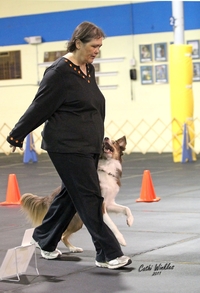Course Details
Clean cues! What are they and how do we get them? As trainers you hear a lot of people talking about their cues. What you will also likely hear and see are people adding and using cues in a less than optimal manner. This can make for some very messy training. There’s very clear science behind how and when to add cues to help your dog learn them as quickly and easily as possible.
In this workshop we will discuss:
- the purpose of cues,
- different modalities of cues,
- the concept of stimulus control,
- natural or unintended cues,
- the strength of current cues,
- the best time to add a cue (not too early, not too late!),
- the concepts of blocking and overshadowing (and how they sabotage your best efforts),
- choosing the best cue for the behavior,
- how to recognize when a cue is not working properly or is poisoned, and
- how to change a cue.
Exercises will include:
- Measuring the reliability of current cues (stimulus control)
- Changing the modality of a current cue
- Cleaning up existing cues
- Adding a new cue to a new behavior
By the end of this workshop you will come away with a much more complete understanding of the concept of cues and how to work with them. Your communication with your dog will become much more focused and clear.
Watch the trailer
Note: This is a repeat workshop that has run previously under a different course number. Please review your workshop library to make sure this would not be a duplicate purchase.
Lecture Publish Date: Sunday February 6th
Video Submissions Due Date: Sunday February 13th @ 12pm noon PT
Feedback & Questions Video Publish Date: Wednesday February 16th
 Instructor: Deborah Jones
Instructor: Deborah JonesDeborah Jones, Ph.D. (she/her) is a psychologist who specializes in learning theory and social behavior. She taught a variety of psychology courses at Kent State University for the past 20 years. Deb has been training dogs for performance events for the past 25 years and was an early...(Click here for full bio and to view Deb's upcoming courses)